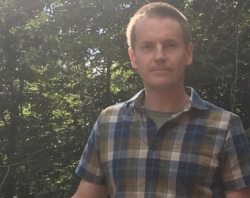

Professor Aaron Dotter will collaborate with researchers from Belgium and France to deliver innovative models of rotating stars that will unlock new insights in the understanding of planetary evolution.
Physics and astronomy professor Aaron Dotter has embarked on a six-year multinational and multidisciplinary research collaboration to create a new way of modeling stars.
Together with fellow principal investigators Conny Aerts from KU Leuven in Belgium and Stéphane Mathis from Université Paris-Saclay and Michel Rieutord from University of Toulouse in France, Dotter was awarded a prestigious Synergy Grant from the European Research Council for the "4D-STAR" project.

Drawing from astrophysics, fluid mechanics, applied mathematics, computer science, and software development, 4D-STAR will model rotating stars in three spatial dimensions. ("4D" counts time as the fourth dimension.)
"This will allow us to properly treat important aspects of stellar physics, mainly driven by rotation, that are lost when we model stars in one spatial dimension," Dotter says. An expert in the computational models of stars, Dotter will focus on the project's computer software component.
The emerging field of space asteroseismology, which studies starquakes with satellites, provides knowledge of the internal structure and evolution of stars. But since researchers began creating computational models of stars in the early 1960s, they've modeled them as perfect spheres—reducing their dimensionality from three to one. This approach neglects the flattening of stars due to their rotation and introduces major uncertainties in confirming the age of stars, which is key to understanding stellar and planetary evolution.
"We're able to model lots of real stars with an impressive level of accuracy," Dotter says. "However, we run into significant problems when stars rotate, which many of them do. This is especially true of stars more massive than the sun."
The European Research Council's Synergy Grants help groups of two to four outstanding researchers bring together complementary skills, knowledge, and resources in one ambitious overarching project to address some of the world's most formidable research problems. 4D-STAR received nearly 10 million euros in funding, which will be distributed among the four institutions.
While most scientific research proposals encompass two-to-three-year projects, 4D-STAR has a six-year time frame.
"One of the main points we made for why this needed to be a long-term, multidisciplinary, multinational project is that we couldn't think of one person or even one university or institute where all of the necessary expertise to tackle this problem is gathered together," Dotter says. "The framework to do what we want to do does not exist right now, so rather than refining existing models or techniques, we are going to create something new. That's the most exciting aspect of it for me."